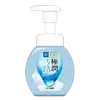What's inside
What's inside
 Key Ingredients
Key Ingredients

 Benefits
Benefits

 Concerns
Concerns

 Ingredients Side-by-side
Ingredients Side-by-side

Water
Skin ConditioningLauric Acid
CleansingSorbitol
HumectantPEG-75
HumectantMyristic Acid
CleansingPotassium Hydroxide
BufferingCocamide DEA
EmulsifyingDecyl Glucoside
CleansingButylene Glycol
HumectantDipotassium Glycyrrhizate
HumectantAminocaproic Acid
Coix Lacryma-Jobi Ma-Yuen Seed Extract
Skin ConditioningHouttuynia Cordata Extract
Skin ConditioningAnthemis Nobilis Flower Extract
MaskingSodium Hyaluronate
HumectantSqualane
EmollientCamphor
MaskingGlycerin
HumectantRosmarinus Officinalis Leaf Oil
MaskingPalmitic Acid
EmollientMenthoxypropanediol
MaskingPEG-80 Sorbitan Laurate
Steareth-20
CleansingSodium Bicarbonate
AbrasivePolyquaternium-39
Disodium EDTA
Alcohol Denat.
AntimicrobialIodopropynyl Butylcarbamate
PreservativePhenoxyethanol
PreservativeWater, Lauric Acid, Sorbitol, PEG-75, Myristic Acid, Potassium Hydroxide, Cocamide DEA, Decyl Glucoside, Butylene Glycol, Dipotassium Glycyrrhizate, Aminocaproic Acid, Coix Lacryma-Jobi Ma-Yuen Seed Extract, Houttuynia Cordata Extract, Anthemis Nobilis Flower Extract, Sodium Hyaluronate, Squalane, Camphor, Glycerin, Rosmarinus Officinalis Leaf Oil, Palmitic Acid, Menthoxypropanediol, PEG-80 Sorbitan Laurate, Steareth-20, Sodium Bicarbonate, Polyquaternium-39, Disodium EDTA, Alcohol Denat., Iodopropynyl Butylcarbamate, Phenoxyethanol
Water
Skin ConditioningButylene Glycol
HumectantDisodium Cocoyl Glutamate
CleansingPEG-8
HumectantCocamidopropyl Betaine
CleansingCocamide DEA
EmulsifyingPEG-80 Sorbitan Laurate
Glycerin
HumectantSorbitol
HumectantSodium Taurine Cocoyl Methyltaurate
CleansingSodium Acetylated Hyaluronate
HumectantHydroxypropyltrimonium Hyaluronate
Petrolatum
EmollientCitric Acid
BufferingPolyquaternium-7
Disodium EDTA
BHT
AntioxidantMethylparaben
PreservativeWater, Butylene Glycol, Disodium Cocoyl Glutamate, PEG-8, Cocamidopropyl Betaine, Cocamide DEA, PEG-80 Sorbitan Laurate, Glycerin, Sorbitol, Sodium Taurine Cocoyl Methyltaurate, Sodium Acetylated Hyaluronate, Hydroxypropyltrimonium Hyaluronate, Petrolatum, Citric Acid, Polyquaternium-7, Disodium EDTA, BHT, Methylparaben
Ingredients Explained
These ingredients are found in both products.
Ingredients higher up in an ingredient list are typically present in a larger amount.
Butylene Glycol (or BG) is used within cosmetic products for a few different reasons:
Overall, Butylene Glycol is a safe and well-rounded ingredient that works well with other ingredients.
Though this ingredient works well with most skin types, some people with sensitive skin may experience a reaction such as allergic rashes, closed comedones, or itchiness.
Learn more about Butylene GlycolCocamide DEA is a coconut-derived cleansing agent that creates rich foam and helps to thicken the consistency of cleansing products.
This ingredient effectively removes dirt and oil while helping to stabilize formulations, making it a common addition to shampoos, body washes, and facial cleansers.
It has become less popular in recent formulations due to potential irritation in sensitive skin types and concerns about trace amounts of diethanolamine (DEA), which can potentially form nitrosamines.
While still considered safe at regulated concentrations, many manufacturers now opt for gentler alternatives like cocamidopropyl betaine or other surfactants that offer similar benefits with fewer potential drawbacks.
Learn more about Cocamide DEADisodium EDTA plays a role in making products more stable by aiding other preservatives.
It is a chelating agent, meaning it neutralizes metal ions that may be found in a product.
Disodium EDTA is a salt of edetic acid and is found to be safe in cosmetic ingredients.
Learn more about Disodium EDTAGlycerin is already naturally found in your skin. It helps moisturize and protect your skin.
A study from 2016 found glycerin to be more effective as a humectant than AHAs and hyaluronic acid.
As a humectant, it helps the skin stay hydrated by pulling moisture to your skin. The low molecular weight of glycerin allows it to pull moisture into the deeper layers of your skin.
Hydrated skin improves your skin barrier; Your skin barrier helps protect against irritants and bacteria.
Glycerin has also been found to have antimicrobial and antiviral properties. Due to these properties, glycerin is often used in wound and burn treatments.
In cosmetics, glycerin is usually derived from plants such as soybean or palm. However, it can also be sourced from animals, such as tallow or animal fat.
This ingredient is organic, colorless, odorless, and non-toxic.
Glycerin is the name for this ingredient in American English. British English uses Glycerol/Glycerine.
Learn more about GlycerinPEG-80 Sorbitan Laurate isn't fungal acne safe.
Sorbitol is a sugar alcohol. It is a hydrating and moisturizing agent created from the reduction process of glucose.
Most sorbitol is usually made from potato starch. It is also found in fruits such as apples and pears.
As a humectant, Sorbitol helps draw water to the skin. This helps keep the skin hydrated. Sorbitol also helps create a thicker texture in products. You might find sorbitol in your toothpaste and other gels.
It is a non-irritating ingredient that is great for those with dry skin.
Sorbitol is a prebiotic. It helps promote the growth of healthy bacteria on your skin. The bacteria on your skin form a microbiome. This microbiome helps protect your skin from infection and harmful bacteria.
Learn more about SorbitolWater. It's the most common cosmetic ingredient of all. You'll usually see it at the top of ingredient lists, meaning that it makes up the largest part of the product.
So why is it so popular? Water most often acts as a solvent - this means that it helps dissolve other ingredients into the formulation.
You'll also recognize water as that liquid we all need to stay alive. If you see this, drink a glass of water. Stay hydrated!
Learn more about Water